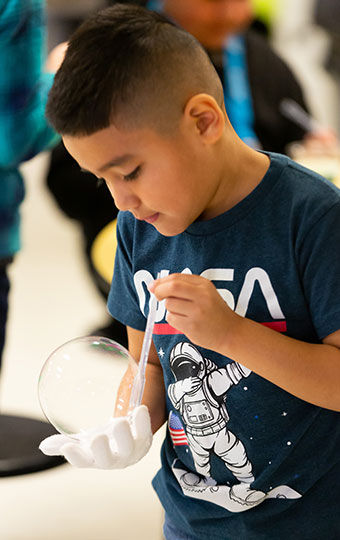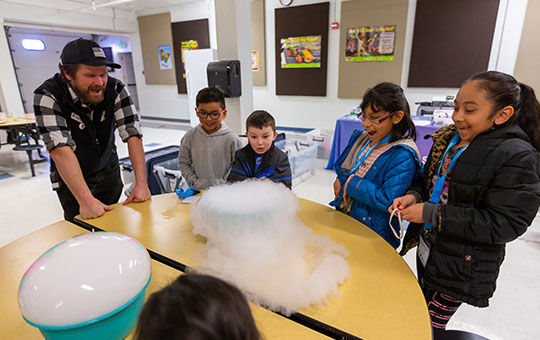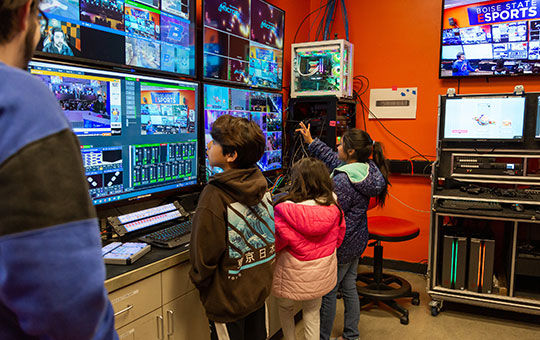Reflections on why STEM education is important and why continued progress is critical to our future workforce
Science, technology, engineering and math (STEM) puts people on the moon, develops lifesaving health care and advances clean forms of energy. The way we live each day — from asking our smartphone’s voice assistant to play our favorite music to connecting with our parents on a video call — is thanks to STEM. That’s why we celebrate National STEM Day every year on Nov. 8 and encourage students to explore and pursue the STEM fields that drive our world forward.
Understanding the growing need for STEM education
By 2030, the number of jobs in STEM fields is expected to skyrocket. In fact, the Semiconductor Industry Association predicts a shortfall of 67,000 workers by the end of the decade. In addition, the Bureau of Labor Statistics estimates that STEM career opportunities are set to grow by 10.8% until 2031, with non-STEM occupations only seeing a growth of 2.3% in that time. Today, that means Micron and other companies within the semiconductor industry have a business imperative to help bridge the STEM education gap and foster access for all groups to prepare the workforce of the future.
While there has been a 62% growth rate in STEM education and degrees earned across the board in terms of race, gender and ethnicity in the United States within the past decade, more work still needs to be done when it comes to developing an inclusive pipeline of STEM talent and encouraging women and people from underrepresented groups to pursue careers in STEM fields. Today, women only make up 35% of the STEM workforce, while people from all underrepresented groups represent 24% and people with disabilities account for a mere 3%.
In my role as chief people officer and president of the Micron Foundation, I've had a front-row seat to the evolving landscape of STEM-related job functions over the years, with a growing emphasis on data-driven decision-making and the increasing integration of technology in various fields. I have seen the value that people from diverse backgrounds bring to the industry, including engineers, data scientists and even technicians who operate our state-of-the-art equipment. And I remain committed to ensuring that our company’s investment in STEM education around the world intentionally creates greater opportunities for women and underrepresented communities.
We operate from a premise that STEM education is a pathway to equity. In a study that explores teachers’ views on the impact of STEM education on the labor market, the results indicate that STEM education supports increased job opportunities, which yields higher economic growth. Unemployment rates are lower among STEM education graduates as are the associated social costs of unemployment. In addition to these positive outcomes, those who receive STEM education become curious and engaged learners and develop entrepreneurial perspectives that open new career possibilities.
Inspiring the world’s youth
Both Micron and the Micron Foundation continue to expand investments in K-12 STEM education programs by building new partnerships with nonprofit organizations, schools, community colleges and universities. Such programs welcome, train and inspire those in underrepresented and rural populations to pursue careers in STEM. Programs include Chip Camp (grades 7-8), Girls Going Tech (grade 8 girls), Careers in a High-Tech World job shadow (grades 10-12) and the recently added Chip Camp Junior (grades 4-5). Through these programs, hundreds of volunteers, educators and mentors share their expertise and time with students while inspiring them to pursue their passions.


Micron has not limited its vision and scope to programs in the U.S. In fact, in 2023, we doubled our K-12 STEM outreach programs by expanding our Chip Camp globally with new offerings in Taiwan, China, Singapore and Japan. Collectively, these programs reached more than 4,500 students and educators this year. In Japan, we partnered with the Girl Scouts of Japan to host the first Chip Camp for Girl Scouts. In Singapore, students visited the Science Centre Singapore and toured a Micron site to learn how semiconductors are made.
In the U.S., the Micron Foundation launched its first STEM programming in the Central New York region, featuring multiple Chip Camps and Girls Going Tech events designed to spark a passion for STEM. One of the Girls Going Tech forums was conducted entirely in Spanish through a partnership with La Liga Spanish Action League and Onondaga Community College. This experience introduced Latina students in the Syracuse area to STEM and is an example of our partnerships with local agencies and community colleges to reach students from diverse backgrounds.
We have also made strides in expanding our signature programs to rural areas. For example, we held our first Chip Camp Jr. in Wilder, Idaho, with a Title 1 school and another camp in Canyon County, near rural school districts and neighborhoods. To facilitate participation, we provided free transportation from the students’ schools to the camp locations.

In Central New York, Micron Technology announced our pledge to invest $10 million over the next decade for the first collaborative STEAM (science, technology, engineering, arts and mathematics) school in the region, alongside support for other STEM-driven K-12 programs in the region. The STEAM school will deliver opportunities to students spanning diverse socioeconomic, racial and geographic backgrounds, and it will nurture New York’s future workforce.
Creating opportunities for all in post-secondary education
In addition to engaging thousands of students in our K-12 education programs over the last 20 years, we also support higher education programs and institutions. We recently launched three university networks to increase access to post-secondary STEM education: the U.S.-Japan University Partnership for Workforce Advancement and Research & Development in Semiconductors (UPWARDS for the Future), the Northwest University Semiconductor Network, and the Northeast University Semiconductor Network. Made up of universities across the United States and Japan, these networks are focused on collectively developing the next generation of semiconductor talent. In partnership with these institutions and the National Science Foundation (NSF), Micron is championing efforts to modernize and enhance curriculum. These efforts include sharing industry-backed technical content, expanding experiential learning programs that will increase access to cleanrooms and teaching labs, and bolstering research opportunities for students.
Leading the industry by example
While Micron has taken a leading role in advancing access to STEM education, it’s vital for the broader industry to act and encourage access to STEM among those who have not traditionally been represented in high-tech industries. The STEM education gap is an opportunity that welcomes stakeholders across markets, businesses, communities and nonprofits. Companies have an important role in helping bridge the gap through strategies including partnerships with educational institutions, internship and apprenticeship programs, inclusive recruitment and hiring practices, and continuous learning opportunities from within their organizations.
Overall, we’ve made great progress in STEM representation globally, but our work is just beginning. To accelerate innovation, we must double down on efforts to welcome and provide access for women, veterans, disabled people, and those from rural and underrepresented communities. We do this by opening new pathways to STEAM schools and community colleges, creating interactive exhibits at museums, like Micron’s recent installation at the Museum of Science and Technology (MOST) in Syracuse, New York, and bringing STEM directly to students who live in rural communities like Wilder, Idaho.
We also know how important it is to remove barriers that prevent caregivers from pursuing education. This is why we support access to childcare, allowing families to know their children are well cared for while they pursue their education and ultimately achieve rewarding, long-term careers.
Celebrating innovation and curiosity
This STEM Day let’s celebrate STEM trailblazers – those who are already leading the way, like the volunteers and mentors who inspire the next generation. Let’s celebrate STEM students – the future innovators who will earn patents and make the breakthroughs that will accelerate our society forward.

